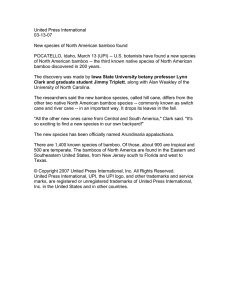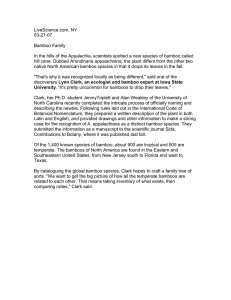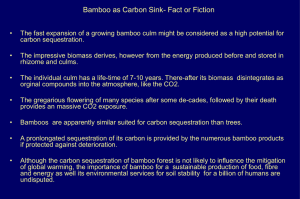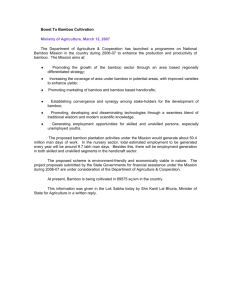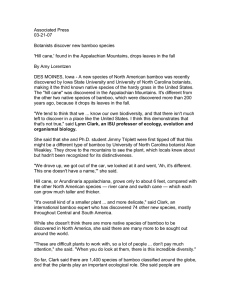Variation in Microstructure and Mechanical Bambusa stenostachya Abstract
advertisement
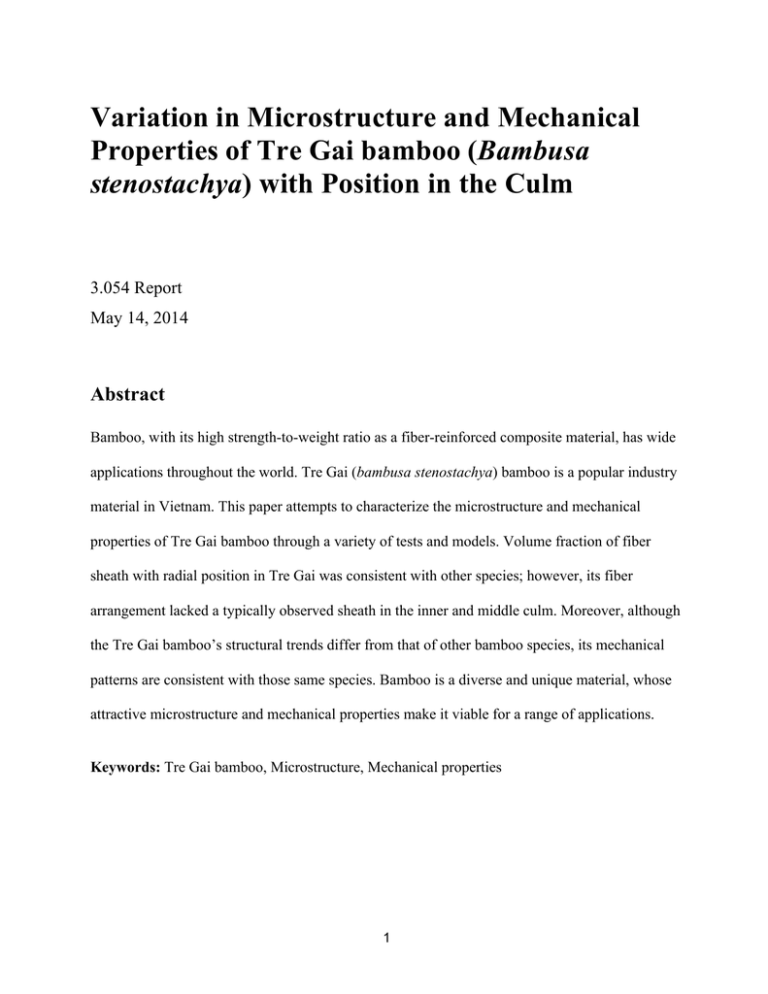
Variation in Microstructure and Mechanical Properties of Tre Gai bamboo (Bambusa stenostachya) with Position in the Culm 3.054 Report May 14, 2014 Abstract Bamboo, with its high strength-to-weight ratio as a fiber-reinforced composite material, has wide applications throughout the world. Tre Gai (bambusa stenostachya) bamboo is a popular industry material in Vietnam. This paper attempts to characterize the microstructure and mechanical properties of Tre Gai bamboo through a variety of tests and models. Volume fraction of fiber sheath with radial position in Tre Gai was consistent with other species; however, its fiber arrangement lacked a typically observed sheath in the inner and middle culm. Moreover, although the Tre Gai bamboo’s structural trends differ from that of other bamboo species, its mechanical patterns are consistent with those same species. Bamboo is a diverse and unique material, whose attractive microstructure and mechanical properties make it viable for a range of applications. Keywords: Tre Gai bamboo, Microstructure, Mechanical properties 1 Table of Contents 1. Introduction and Overview…………………………………………………………… 3 2. Theoretical Background……………………………………………………………… 4 3. Materials and Methods……………………………………………………………….. 7 3.1 Microscopy and Image Analysis………………………………………………. 7 3.2 Flexural Strength and Elastic Moduli………………………………………….. 8 4. Results……………………………………………………….……….……….………. 9 4.1 Macrostructure……………………………….……….………….……………. 9 4.1 Microstructure……………………………….……….……….……….…….…. 10 4.2 Mechanical Strength……………………………….……….……….…………. 13 5. Discussion……………………………………………………………………….…..... 16 6. Conclusion…………………………………………………………………………...... 18 7. Proposed Future Work …………………………………………………………….…. 19 8. Acknowledgments…………………………………………………………………….. 20 9. References…………………………………………………………………………….. 21 List of Figures and Tables Figure 3.1 Tre Gai bamboo………………………………………………………………. 8 Figure 3.2 Internode diameter, length, and thickness…………………………….............. 9 Figure 4.1 Tre Gai bamboo structure in cross section of the first internode……………… 10 Figure 4.2 Parenchyma in the first internode……………………………………… …….. 10 Figure 4.3 Vascular bundle volume fraction with varying normalized radial position…... 11 Figure 4.4 First internode, inner vascular bundle and outer vascular bundle……………. 12 Figure 4.5 Ninth internode outer vascular bundle…………………………….................... 12 Figure 4.6 Longitudinal section showing parenchyma and fibers.……….……….. ……... 13 Figure 4.7 Flexural strength and elastic moduli with varying density…………………… 14 Figure 4.8 Flexural strength and elastic moduli with varying normalized radial position... 15 2 1. Introduction and Overview Bamboo, a material of high strength-to-weight ratio, is widely applied throughout the world. It is applicable to many environmental and economic possibilities, including construction and development. The uniqueness of its mechanical properties leads to endless potential applications. Bamboo is a fiber reinforced composite with a distinct modulus gradient on the cross section. This is different from wood, which consists of a more homogenous cellular material. The hollow, tough stem, or culm, of the bamboo is divided by a number of nodes and consists of vascular bundles in a matrix of parenchyma cells. The density of these bundles increases radially as well as by height. The mechanical properties of the bamboo depend largely on the structural variation and components that make up the vascular bundles. This paper will focus on the characterization of the microstructure and mechanical properties of Tre Gai (bambusa stenostachya) bamboo. Flexural strength and elastic moduli will be tested with respect to density and radial position. The bamboo microstructure will then be related to these mechanical properties in hopes of obtaining a better understanding of the mechanical characterization of Tre Gai bamboo. 3 2. Theoretical Background Bamboo is widely used throughout the world, particularly amongst Asian countries where it is abundant. It has a large strength-to-weight ratio making it applicable to many environmental and economic possibilities. For example, the use of bamboo is abundant in the wood, paper, and pulp industries today.1 It is also a means of rural development as bamboo is easily grown, harvested, accessible, and affordable.2 Tre Gai (bambusa stenostachya Hackel) bamboo in particular is a popular, native species to Vietnam and a significant industry resource.3 This paper will focus on the mechanical properties of Tre Gai bamboo in hopes of contributing to the comparison between it and other commercially important species, such as that of Moso bamboo (phyllostachys pubescens) popular in China. A member of the grass family, bamboo itself is unique due to its rapidly growing woody stem and tall heights.2 Bamboo is modeled as a fiber-reinforced bio-composite with a distinct modulus gradient on the cross section of its hollow stem, or culm. This inhomogeneity differs from wood, which exhibits a more homogenous cellular material and obtains its strength from thickening cell walls.4 The bamboo’s culm consists of many nodes which divide the stem into a number of internodes. Depending on the height, internodes differ from each other in length, wall thickness, diameter, and material properties. The culm wall is composed of a functional gradient of dense vascular bundles embedded in a matrix of parenchyma cells.1 These vascular bundles are composed of vessels and sieve tubes, surrounded by sclerenchyma tissue. Sclerenchyma is composed of fibers that appear in the shape of cups around outer faces of vessels; however, the fiber strands take many forms in different culm positions and heights, as well as in varying bamboo species. Generally, there are vascular bundle types that exhibit distinct supporting sclerenchyma fiber sheaths, those that contain some 4 distinct supporting fiber sheath with one strikingly larger sheath in an intercellular space, or those with two large fiber strands outside the central sheath-supporting strands.1 Inner culm regions tend to contain more distinct supporting fibers, while outer regions favor large fiber strands in the immediate intercellular space outside vascular bundles. In the culm wall, the density of these vascular bundles increases towards the outer wall, or cortex, and decreases towards the inner wall, or pith. The density also increases gradually with height. Finally, all cells are lined axially, although this alignment may differ at the nodes. The mechanical properties of bamboo depend on all of the above factors. The mechanical factors of interest center around the flexural strength, or modulus of rupture (MOR), and elastic moduli (MOE). The flexural strength is a measure of a material’s ability to resist deformation under a load. The flexural strength for a rectangular specimen under three-point bending can be calculated using: σ= 3Pb wt ! where P is the load at fracture, b is the span, w the width, and t the thickness of the beam. 𝜎 represents the maximum stress the specimen can withstand until rupture. Similarly, the elastic moduli can be calculated using: mb! E= 4wt ! where m is the linear slope of the flexural strength stress-strain curve, b is the span, w the width, and t the thickness of the beam. 𝛦 represents the specimen’s ability to deform elastically when the load P is applied to it. Both flexural strength and elastic moduli are prime indicators of the bamboo’s strength. 5 In this paper, the mechanical properties and microstructure of Tre Gai bamboo were explored. Flexural strength and elastic moduli of samples from different internodes and radial positions were tested. These values were plotted with respect to density and radial position, then analyzed according to a variety of filters. Following this, the bamboo microstructure was related to its mechanical properties and further discussed. Ultimately, the goal of characterizing this bamboo will be to provide a basis for understanding and comparing Tre Gai with other widely used species. 6 3. Materials and Methods The lower ten nodes of dried Tre Gai bamboo culm was imported from Vietnam. The internode diameter, length, and thickness were all measured prior to making the final samples. 3.1 Microscopy and Modeling Cross sections of Tre Gai bamboo culm at various internodes were analyzed via microscopy. Roughly 10mm thick culm microscopy sections were cut and prepared by surface polishing perpendicular to the fiber axis, on grinding paper. Progressively finer grit size ranging from 800 to 4000 was used for 5-10 minutes each with deionized water, and samples were laid to dry for 48 hours. Samples from internodes 1, 5, and 9 (with 9 being the highest internode) were imaged using a JOEL JSM- 6610LV Scanning Electron Microscope to show structure. Images were obtained in the LSEI mode at 50X magnification under 20kV and 30Pa from the inner to outer walls. Full culm images were stitched using imaging software to show continuous structure to analyze volume fraction of vascular bundles with respect to radial position. Image analysis was performed manually on ImageJ by separating fiber regions from other culm constituents to a binary-processed image, and measuring volume fraction of filled fiber bundles at radial increments. SEM images of parenchyma, vascular bundles, fibers, and longitudinal sections (BEC mode used), containing both constituents were also obtained at higher magnifications. 7 3.2 Flexural Strength and Elastic Moduli Bending samples from internodes 1, 5, and 9 were created by splitting axially and radially along the culm wall (Figure 3.1 left, middle). Three pieces were cut from each internode, and the cortex and pith of each was sanded off. Each of these were then radially cut into four more pieces and sanded to even out the dimensions as much as possible. A total of 36 samples were created, as can be seen on the right in Figure 3.1 below. These samples had an average length of 13.3 ± 0.6 cm, average width of 16.3 ± 1.7 cm, and thickness ranging from 0.2 - 0.6 cm. The density of each sample was measured, and ranged from 200 - 800 kg/m3. Beams were tested in three-point bending, with outer surfaces face up, speed 1 mm/min and the span-to-depth ratio no less than 20. Figure 3.1 Left: Tre Gai bamboo before splitting. Middle: Internodes 1, 5, and 9. Right: Finished samples for three-point bending. 8 4. Results 4.1 Macrostructure The diameter of the culm averaged to 6.8 ± 0.1 cm, with a bell shaped distribution, peaking at halfway along the height of the culm (Figure 3.2, top). With respect to culm height, the length of the internodes decreased linearly, ranging from 26.0 cm to 20.1 cm, while internode thickness increased linearly, ranging from 13.2 ± 0.9 cm to 18.3 ± 1.3 cm (Figure 3.2, middle, bottom). Figure 3.2 Internode diameter (top), length (middle), and thickness (bottom) with varying internode number. 9 4.1 Microstructure The structure of Tre Gai bamboo in the first internode is shown in Figure 4.1 (top), characterized by vascular bundles of consistent orientation within a parenchymal matrix. Bundles are larger at the inner wall and become gradually smaller and more densely packed towards the outer wall. Vascular bundles consist of two large vessels and a sieve tube in a triangular arrangement, with outer faces of the bundles surrounded with sclerenchyma fiber. Parenchyma (Figure 4.2) surrounds the constituents of the bundle arrangement. A longitudinal section of the culm with sclerenchyma fibers in parenchyma is shown in Figure 4.6. Figure 4.1 Top: Tre Gai bamboo structure in cross section of the first internode. Bottom: binary-processed image of cross section Figure 4.2 Parenchyma in the first internode. 10 To obtain the volume fraction of fibers, images were processed using ImageJ to separate the sclerenchyma from other culm constituents, as shown for the first internode in Figure 4.1 (bottom). Dark elements of the binary-processed image were counted to experimentally measure the volume fraction of fibers. Figure 4.3 shows volume fraction of fibers as a function of normalized radial position. In the first internode, volume fraction increased from approximately 0.08 to 0.40; in the fifth internode, volume fraction increased from 0.04 to 0.42. Figure 4.3 Vascular bundle volume fraction with varying normalized radial position. Images of inner bundles (Figure 4.4, left) and outer bundles (Figure 4.4, right) were documented in the first internode, and ambiguous fiber-parenchyma regions were observed. While outer bundles contain four fibrous regions with an additional ambiguous region of immature fiber, inner bundles displayed only three fibrous regions around the vessels and phloem with the midpoint of the culm being the approximate boundary. A similar ambiguous region of material is observed in inner bundles, but resembles smaller, denser parenchyma rather than fiber. 11 In Figure 4.5, a vascular bundle near the outer culm is shown, where the fiber regions have grown into one another, and a dense parenchymal region that does not resemble mature fiber is present. Figure 4.4 First internode, inner vascular bundle (left) and outer vascular bundle (right). F denotes fiber and A is the ambiguous region. Figure 4.5 Vascular bundle in the outer ninth internode with two mature fiber sheaths. F denotes fiber and A is the ambiguous region. 12 Figure 4.6 Longitudinal section showing parenchyma and fibers. 4.2 Mechanical Strength Of the 36 samples prepared, 29 were successfully tested for flexural strength and elastic moduli. Figure 4.7 (top) shows how the flexural strength (MOR) of the Tre Gai bamboo vary with sample density, while Figure 4.7 (bottom) shows how the elastic moduli (MOE) of vary with sample density. Both flexural strength and elastic moduli appear to follow a consistent, quadratic trend with density. Separating by internode also exhibits the same consistent increase for both. 13 Figure 4.7 Top: Flexural strength of Tre Gai bamboo with varying density. Bottom: Elastic moduli with varying density. Figure 4.8 (top) shows the Tre Gai bamboo flexural strength as a function of radial position, r, normalized by the total wall thickness, a, while Figure 4.8 (bottom) shows the elastic moduli (MOE) as a function of normalized radial position. Both flexural strength and elastic 14 moduli appear to follow a consistent, quadratic trend with radial position. Separating by internode also exhibits the same consistent increase for both. Figure 4.8 Top: Flexural strength of Tre Gai bamboo with varying normalized radial position, r/a. Bottom: Elastic moduli with varying normalized radial position. 15 5. Discussion Tre Gai bamboo exhibits generally the same characteristics as other bamboo under study. In this discussion, Tre Gai bamboo will be compared to Moso bamboo, a popular and well-studied species. According to the macrostructure, with respect to height, the diameter of the Tre Gai culm shows a bell shaped distribution, the internode length decreases linearly, and the internode thickness increases linearly. In comparison, for Moso bamboo, with respect to height, the culm diameter decreases linearly, the internode length increases by a power of 0.5, and the internode thickness decreases exponentially.5 This poses quite an interesting outcome as none of the parameters in the Tre Gai bamboo exhibit the same trends. The consistency of the data, however, suggests that the Tre Gai may simply have fundamentally different patterns. Microscopy on the first and fifth internodes indicates that the volume fraction of fibers in Tre Gai increases with radial position in the culm up to approximately 0.4 at the outer wall, consistent with trends shown in Moso bamboo. Between these two internodes, it can be inferred that volume fraction of fiber also increases with height. Data for the ninth internode is not reported because greater culm thickness posed difficulty in image processing. Despite consistent trends in volume fraction values, Tre Gai showed a key difference from Moso in that an additional (fourth) region of sclerenchyma fiber was absent from most bundle clusters towards the inner wall, often showing instead a large ambiguous circular cluster of dense parenchyma or underdeveloped sclerenchyma fiber sheath. This region is not observed in Moso bamboo or addressed in other bamboo work. Only beginning after the midpoint of the culm wall were additional distinct sclerenchyma sheaths apparent. 16 For mechanical properties, the data of elastic moduli against radial position is consistent with that of Moso bamboo.6 However, Moso bamboo does appear to have a slightly higher elastic moduli. Overall, though, the trends and values complement one another. An important point to note is that the extrapolated trend lines for both the MOR and MOE do not cross the origin, unlike what is commonly seen for wood models. This is due to bamboo’s fiber reinforced structure as opposed to wood’s strength from thickening cell walls. One qualifier for the normalized radial position must be addressed. Although the total culm wall thickness of each internode was measured, the wall thicknesses minus the cortex and pith which were sanded off were not measured. Thus, the current values of radial position, r/a, are normalized against the total wall thickness a, but the actual thickness measurements, r, take into account the sanded off cortex and pith. As a result, the values for each normalized radial position may be slightly off. However, because this is a consistent pattern for each sample, the trends above may still be considered with confidence. 17 6. Conclusion Tre Gai bamboo is a widely used material with unique yet sound microstructure and mechanical properties. Microscopy has shown that Tre Gai follows similar trends for volume fraction of schlerancyma fiber with radial position in the culm as other bamboo species such as Moso. However, it is noted that Tre Gai exhibits ambiguous regions resembling dense parenchyma or underdeveloped fiber where Moso has an additional fibrous region. In terms of mechanical strength, though the trends of its internode length, diameter, and culm wall thickness differ from that of the well-studied Moso bamboo, similar trends of elastic moduli against radial position are observed. This reveals the diverse structures of bamboo, which ultimately constitute the same mechanical and microstructural patterns that contribute to its various potential applications. 18 7. Proposed Future Work Much is left to be learned about Tre Gai bamboo. Further microscopy and analysis may be used to better understand the constituents of the ambiguous parenchyma-fibrous regions of the inner Tre Gai culm. The partial fiber regions can be included in further volume fraction analysis to identify how they account for differences in Tre Gai mechanical property in comparison with bamboos that exhibit the classical bundle structure. Additional study can elaborate on the trend of volume fraction sclerenchyma with Tre Gai internode number, or height. In terms of mechanical strengths, flexural strength and elastic moduli may be tested in a radial or transverse orientation, in comparison to axial strengths. Further work may also be done to illustrate the compressive strengths of the Tre Gai bamboo, both axially, radially, and transversely. These values may then be compared with each other as well as amongst other species like Moso bamboo or wholly different material such as wood. This project provides a clear overview of Tre Gai bamboo’s microstructure and mechanical properties. Still, much more needs to be done before it is possible to truly understand and compare the integrity of Tre Gai to other bamboos. 19 8. Acknowledgements We would like to thank Prof. Lorna Gibson for her suggestions and advice and Patrick Dixon for his continuous guidance throughout the scope of the project. 20 9. References 1. Grosser, D.; Liese, W. “On the Anatomy of Asian Bamboos, with Special Reference to their Vascular Bundles,” Wood Science and Technology, Volume 5, 1971, Pages 290-312. 2. Mitch, D. “Splitting Capacity Characterization of Bamboo Culms,” University of Pittsburg Swanson School of Engineering Thesis, March 2009. 3. Tang, T.K.H. “Preservation and drying of commercial bamboo species of Vietnam,” University Hamburg Centre of Wood Science Dissertation, September 2013. 4. Shao, Z.P.; Fang, C.H,; Huang, S.X.; Tian, G.L. “Tensile properties of Moso bamboo (Phyllostachys pubescens) and its components with respect to its fiber-reinforced composite structure,” Wood Science Technology, Volume 44, 2010, Pages 655-666. 5. Amada, S. et al. “The Mechanical Structures of Bamboos in Viewpoint of Functionally Gradient and Composite Materials,” Journal of Composite Materials, Volume 30, No. 7, 1996, Pages 800-819. 6. Dixon, P.; Gibson. L. “Understanding the structural properties of Moso bamboo to engineer sustainable structural bamboo products.” 21 MIT OpenCourseWare http://ocw.mit.edu 3.054 / 3.36 Cellular Solids: Structure, Properties and Applications Spring 2014 For information about citing these materials or our Terms of Use, visit: http://ocw.mit.edu/terms.

